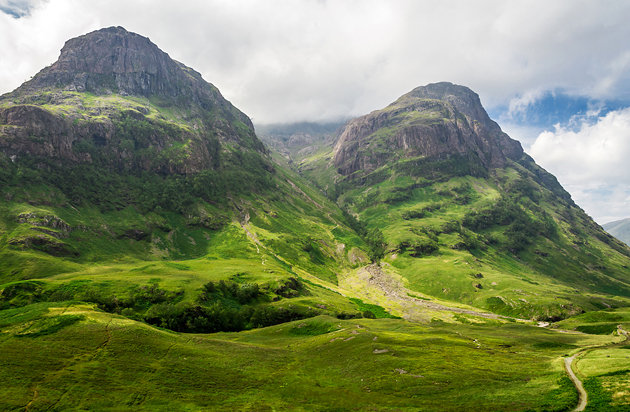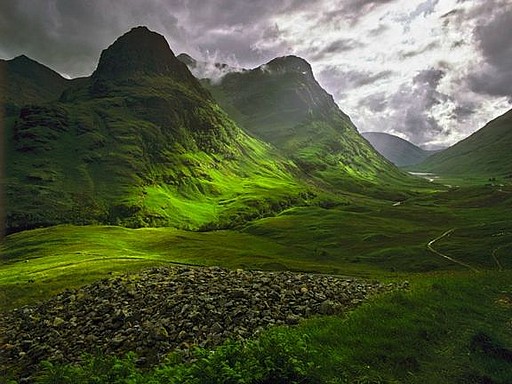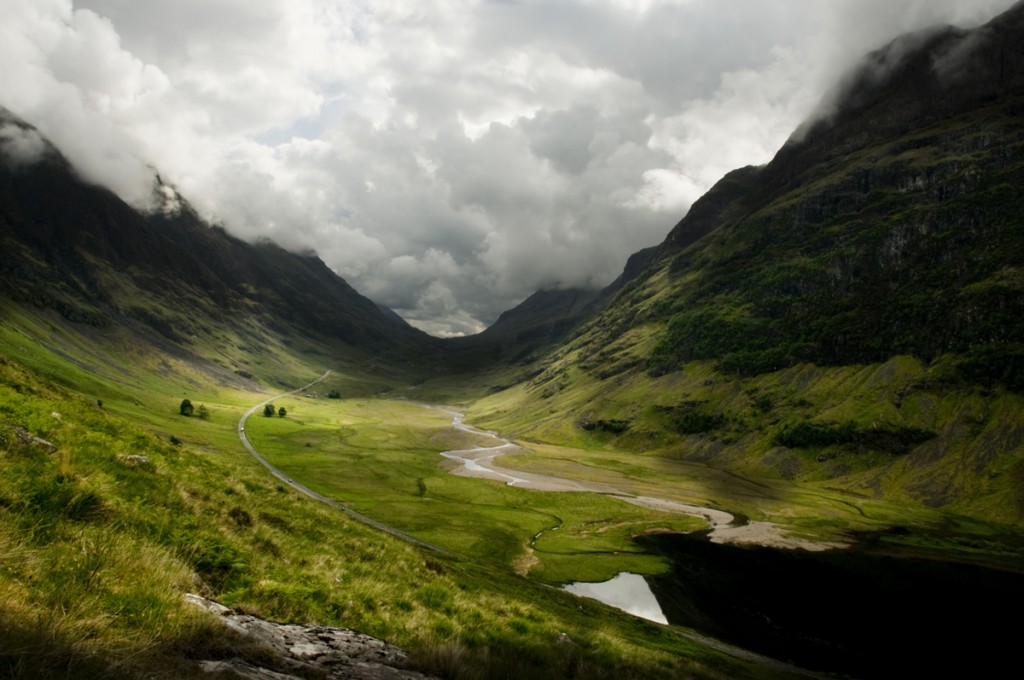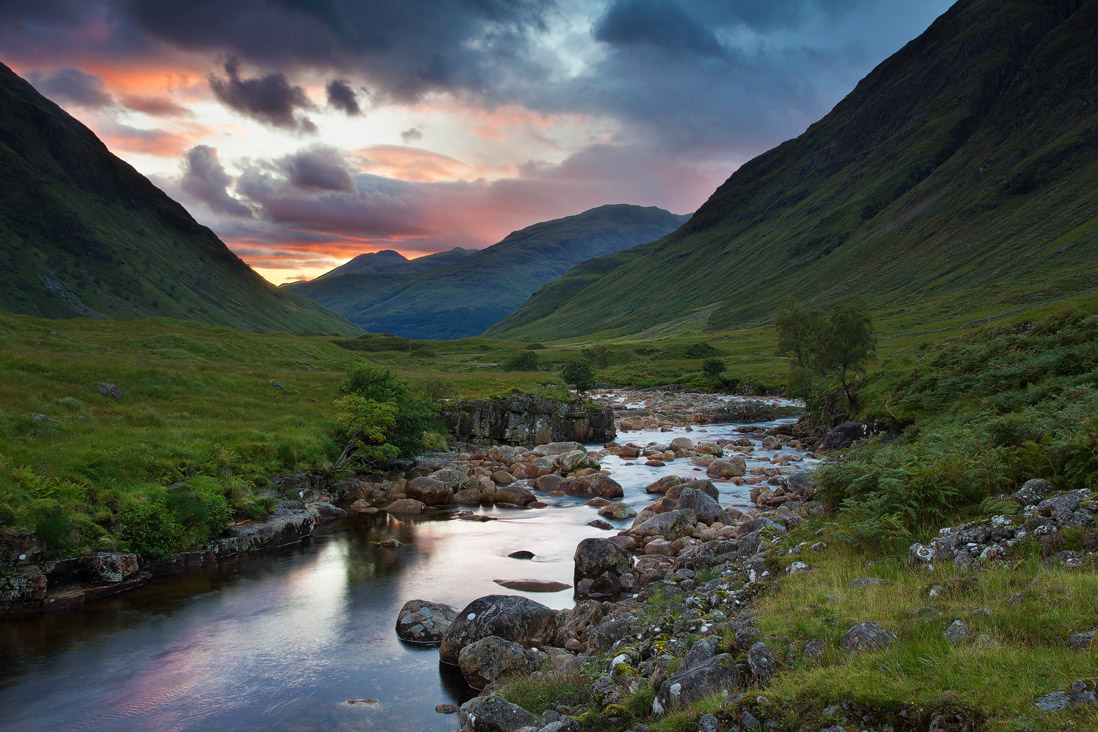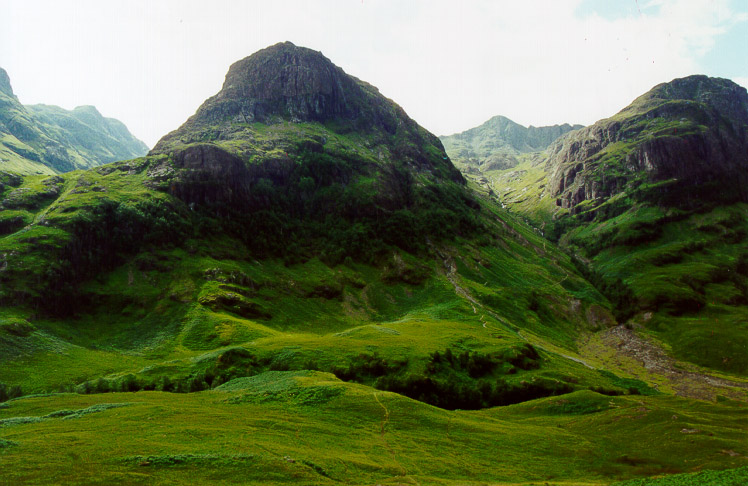Glen Coe (Scottish Gaelic: Gleann Comhann, pronounced [klan̪ˠˈkʰo.ən̪ˠ]) is a glen of volcanic origins, in the Highlands of Scotland. It lies in the north of Argyll, close to the border with Lochaber. It is often considered one of the most spectacular and beautiful places in Scotland, and is a part of the designated National Scenic Area of Ben Nevis and Glen Coe. The narrow glen shows a grim grandeur. The glen, approaching from the east on the main A82 road, is surrounded by wild and precipitous mountains. Further west at Invercoe, the landscape has a softer beauty before the main entrance to the glen. The main settlement is the nearby village of Glencoe located at the foot of the glen.
The name Glen Coe is often said to mean "Glen of Weeping", perhaps with some reference to the infamous Massacre of Glencoe which took place there in 1692. However, "Gleann Comhann" does not translate as "Glen of Weeping". In fact the Glen is named after the River Coe which runs through it, and bore this name long before the 1692 incident. The name of the river is believed to predate the Gaelic language and its meaning is not known. It is possible that the name stems from an individual personal name, Comhan (gen. Comhain).
Glen Coe is a very popular tourist destination: partly because of its scenic qualities and historical associations, partly because it is on the main road north (the A82), and also because of its attraction for walkers and climbers. It is famous for the quality, and variety of its winter climbing, most of its routes being comparatively easy to access from the main road.
Many walkers come to Glen Coe on the West Highland Way following the old military road over Rannoch Moor which crosses the River Etive at the Kings House Hotel. From there it is about 2 km (1.2 mi) to the head of the glen, then about 2 km into the glen the Way ascends the Devil's Staircase, a steep, boulder-strewn "cut" (352 m high) which is part of the old military road and drove road north across the hills to Kinlochleven.
For hillwalkers there are several good routes on the Bidean nam Bian (1,150 m) massif which forms a complex Y-shaped hill with several lesser tops, including Stob Coire Sgreamhach (1,072 m) which also has Munro status. One attractive way in to these tops ascends from the Pass of Glen Coe up along the Hidden Glen, Coire Gabhail, to the ridge. Both Buachaille Etive Beag (958 m) and Buachaille Etive Mòr (1,022 m) also offer opportunities to hillwalkers.
Rock climbers concentrate on the Buachaille Etive Mòr (1,018 m), often called simply "The Beuchle", and on the various routes on the Three Sisters (shoulders of Bidean nam Bian). For adventurous experienced walkers, the finest mainland scramble in the UK is the Aonach Eagach. This extended scramble boasts two of Scotland's trickiest Munro hills, Sgorr nam Fiannaidh (996 m) and Meall Dearg (951 m). The Aonach Eagach ridge terminates at the Pap of Glencoe (741 m).
The Glencoe ski centre, also known as the White Corries, is on the hill of Meall a' Bhuiridh (1,108 m) which is on the east side of Glen Etive, outside Glen Coe proper. This centre is popular with locals and is used by many skiers from the Glasgow area as the nearest ski resort at under 80 miles (130 km) from the city centre. It forms part of the "Black Mount" estate, which is based on Loch Tulla which is to the South East.
Other points of interest include The Study at the Pass of Glen Coe; the cave of Ossian, where tradition says that he was born. The Iona cross was erected in 1883 by a Macdonald in memory of his clansmen who perished in the massacre of 1692. There is car parking at the scenic waterfalls in the Pass of Glen Coe, which was used as the location for "The Bridge of Death" and "The Gorge of Eternal Peril" in filming Monty Python and the Holy Grail, attracting Monty Python pilgrims. Sets for the third Harry Potter film, Harry Potter and the Prisoner of Azkaban, were built near to the bottom of Clachaig Gully, north of the Clachaig Inn. There are also some shots of the eastern glen, including Buachaille Etive Mòr in Skyfall, but that was mainly filmed in Glen Etive There is a folk museum in Glencoe village.




